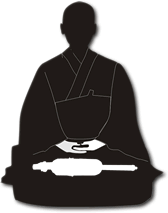Breathing Exercises:.
Recommended Frequency and Duration :.
Frequency: at least once a day, but can become more as one gets accustomed to this exercise
Duration: when beginning, 5 - 10 minutes is a good starting point and can be increased, comfort and time permitting.
Overview :.
While most may take breathing for granted or consider it a basic necessity that everyone knows how to do, good breathing technique is fundamental to clearer minds, better focus, and more energy for other exercises. The purpose behind breathing exercises is to help train one's body to breathe more effectively, making more complete use of one's lung capacity. Deeper breathing is also a means by which one can better cleanse the body and open one's mind.
Abdominal Breathing :.
Those who have had formal martial arts training shoudl be familiar with this techique. However, for many, this exercise may not seem to obvious at first, but the difference in breathing effectiveness is quite significant.
For the untrained, most use chest-breathing. In other words, while the diaphragm (the large muscle region just above the stomach) is used partially, most of the muscles used for breathing are one's chest muscles expanding the rib cage outwards, then releasing to squeeze air out. The limitation with this method of breathing is that it does not promote full exchange of air within the lungs. In fact, when chest breathing, one is likely only effectively changing 50-60% of one's true lung capacity. For more demanding tasks, one will find oneself short of breath.
As opposed to relying on one's chest to breathe, instead, this exercise is meant to help one train to use one's abdomen. By using abdominal muscles as oppose to chest muscles, one can exchange much more of one's lung capacity during each breath. For those just beginning, it is not recommended to perform abdominal breathing exercises for prolonged periods of time. 5 to 10 minutes at a time should be more than adequate until the breathing becomes more natural. Nothing should feel forced or strained; if any part of the exercise begins to make one feel ill or strained, stop immediately. Properly done abdominal breathing should make one feel better, clearer headed. The abdominal breathing exercise compliments well with silent meditation.
To begin, find a quiet place where one can sit comfortably, undisturbed. Sitting on a chair or sitting on the floor/mat/cushion are all viable options. Once seated, relax one's shoulders and arms, but keep one's back, neck, and head upright. Place one's right hand upon one's abdomen and one's left hand upon the right one. Breathe deeply, but slowly inwards through the nose, expanding one's abdomen, not one's chest, to take in the air. Your hands should feel one's stomach protruding further forward as one inhales. The idea here is to "fill one's belly". One should be able to count in one's mind slowly at least until three while inhaling, otherwise one is breathing in too quickly. Feel the good, clean air enter one's body. Once one can inhale no further, hold your breath for the count of three, then slowly exhale through one's mouth using one's abdominal muscles to push out the now stale air. Feel the warm, spent air exit your body as you exhale. As with inhaling, exhaling should not be rushed; exhaling faster than the count of three means it is too quick. To ensure one is using one's abdomen, one should feel and even assist one's diaphagm by gently pushing one's hands inwards during the exhale. Once one can exhale no further, pause for the count of three, the repeat, always inhaling through the nose and exhaling through the mouth. For those just beginning, repeat this 10-20 times or for five minutes, whichever feels comfortable. Those more comfortable may continue for as long as time permits.
When inhaling, the tip of one's tongue should lightly touch the roof of one's mouth. While exhaling, the one's tongue should press gently on the back of one's bottom front teeth.
Some Details on the Process :.
Inhaling through one's nose allows the air entering the body to be warmed and moistened by the nasal passage before entering the lungs. This warmer, moister air is much more pleasing to the lung as opposed to air entering via the mouth. A few deep breaths in through the mouth and one's throat will feel parched, dried uncomfortably by the incoming air.
Pausing after the full inhale gives the body a chance to exchange the oxygen and carbon dioxide in the blood with that in the lungs. Breathing too quickly can lead to hyperventilation which, interestingly enough, causes a drop in internal carbon dioxide levels that actually makes it harder for the blood to deliver oxygen to the rest of the body. While carbon dioxide is typically considered a waste product from respiration, a base level is still needed in the blood, otherwise cells will suffocate since the blood would hold onto bound oxygen too tightly.
Breathing out through the mouth allows one to complete the cycle of exchanging as much of the air within one's air passages as possible. The warmed, moistened air from the lungs further moistens the back of the throat and mouth as it exits while the larger opening of one's mouth allows for smoother airflow out of the body.
Points to Remember :.
- use abdominal muscles to control breathing speed and depth, chest should hardly move if at all during the breathing process
- inhale slowly through the nose; tip of tongue touching roof of the mouth
- hold breath for the count of three
- exhale slowly through the mouth, tip of tongue touching back of bottom teeth
- count to three before inhaling again


